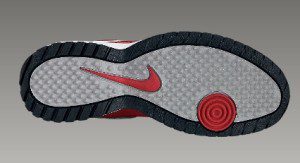It’s hard to say how many clients I’ve had, as a personal trainer, who show up for cross training classes in running shoes. Somewhere deep down inside, my soul cries out, “Noooooo!”
If there’s one thing I know for sure, it’s this: Footwear matters.
Footwear is the reason some individuals can’t exercise due to back or knee pain.
Footwear is the reason I can achieve more speed and agility in my workouts.
Footwear is the reason I see many individuals tumble over sideways and/or lack coordination in balance exercises.
Footwear matters.
To put it simply, there are typically two types of “gym shoes.” Running and walking shoes (intended for forward motion of the body) and cross-training shoes (intended for multiplanar movements). And while we could offer a dissertation on proper running footwear (we’ll save that for another post), because we deal mostly with clients who are cross-training at home or in the gym, that’s where our focus lies for the purposes of this post.
First, let’s take a look at the sole of a typical running shoe:
You can tell by looking at this sole (especially if you were to be looking at it in person versus via phone or computer), that there is significant “grip” to the shoe, allowing for great traction. You can also see that the shoe is intended for someone propelling themselves forward, such as in a running motion. In the average runner, the heel strikes first, followed by the arch of the foot before springing off the toe. The shoe, therefore, is designed to help facilitate that motion. Wear this shoe in and try to shuffle side-to-side and you’ll feel stuck.
“I feel like I’m going to roll my ankle when I wear these running shoes for Insanity,” one of my clients recently told me.
Point proven.
Running shoes are NOT intended for lateral motion!
Now, let’s take a look at a modern cross-trainer:
Here, you can see a couple of things:
- The entire sole looks the same. There is no set “landing” point of the shoe, and no change in traction as you’d see in a running shoe.
- The circular spot on the ball of the foot pictured here is now common in cross-trainers for individuals who are either dancing or performing lots of twists and pivots off their toes (such as in an agility style workout). Pretty cool, huh?
So why does all of this matter?
Well, not only are we advocates of being fashionable, we also care about protecting your feet. Why? Because your feet are the foundation of your overall posture, and your posture indicates your short/tight muscles, as well as your long/weak muscles. And THOSE muscles are more prone to injury. In short, footwear contributes to posture which contributes to musculature which contributes to injury; therefore, footwear can contribute to injury.
Which is why we want you to take this seriously. If you’re not sure what the shoes in your closet are, and if they’re right for the workout you’re doing most days, reach out. We’d love to take a look and help you out. (That’s the awesomeness of a virtual trainer!) But most likely, if the sole is chunkier, you’re looking at a running shoe.
How do you know which type of cross-trainer or running shoe (if you’re a runner) is right for you? This question is SO specific to your foot, your posture, and your workout. You’re going to have to try them on! Visiting your local footwear store should be helpful, but pay attention to the labeling on the walls: Running/Walking vs. Cross-Training, and choose accordingly.
Long story short, the efficiency of your workout and the progression of your fitness relies on your choice in footwear, amongst other things. Don’t assume that since you have a comfy pair of kicks, they should be good enough for your recent dive into the 21 Day Fix. Make sure you’re prepared heading into a new program, class, or style of workout, and yes… That means you now officially have our permission to shop.
Happy hunting!
Yours in Health & Fitness,
Jenny L. Swisher
Founder, Body Electric
CPT/FNS/Owner RevolutionX Studio, LLC


